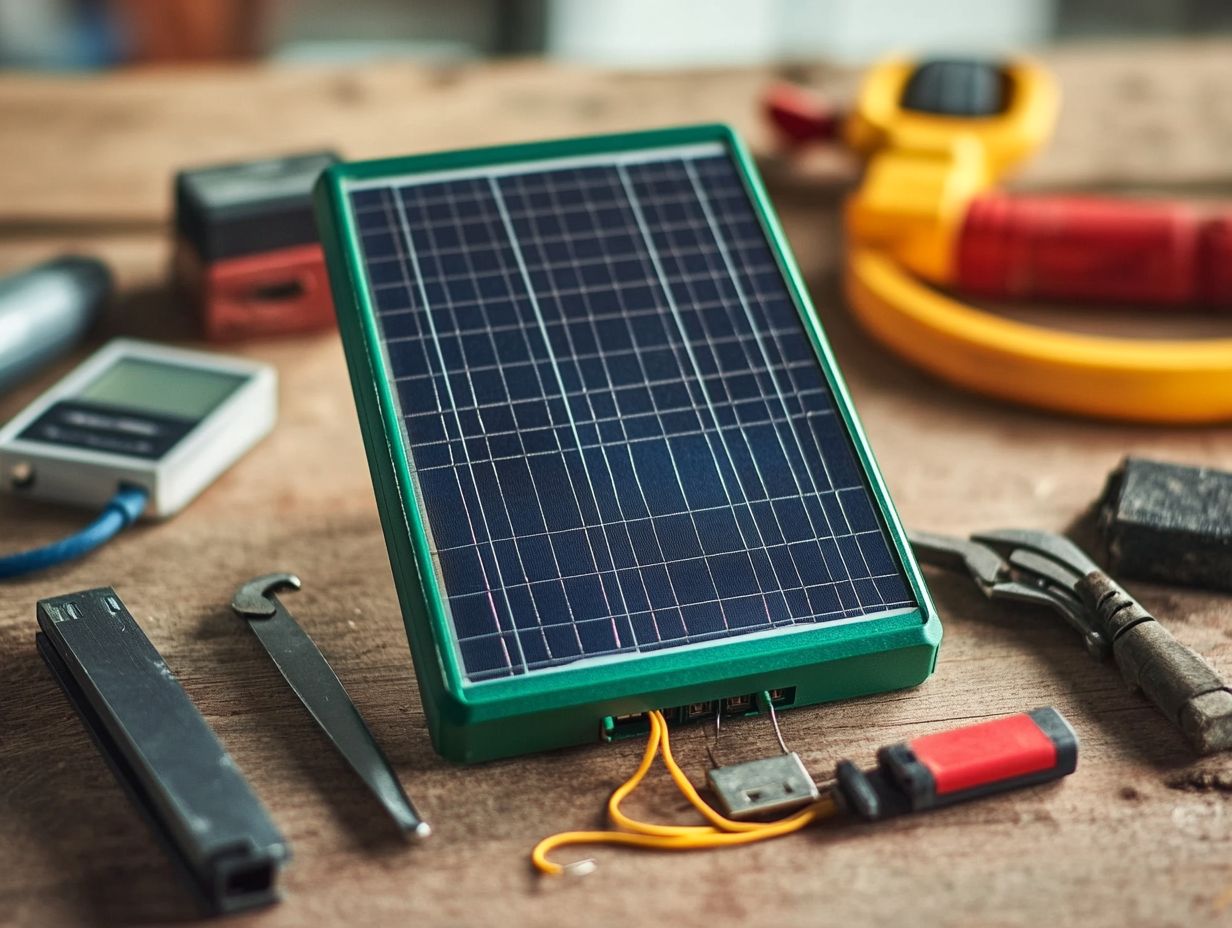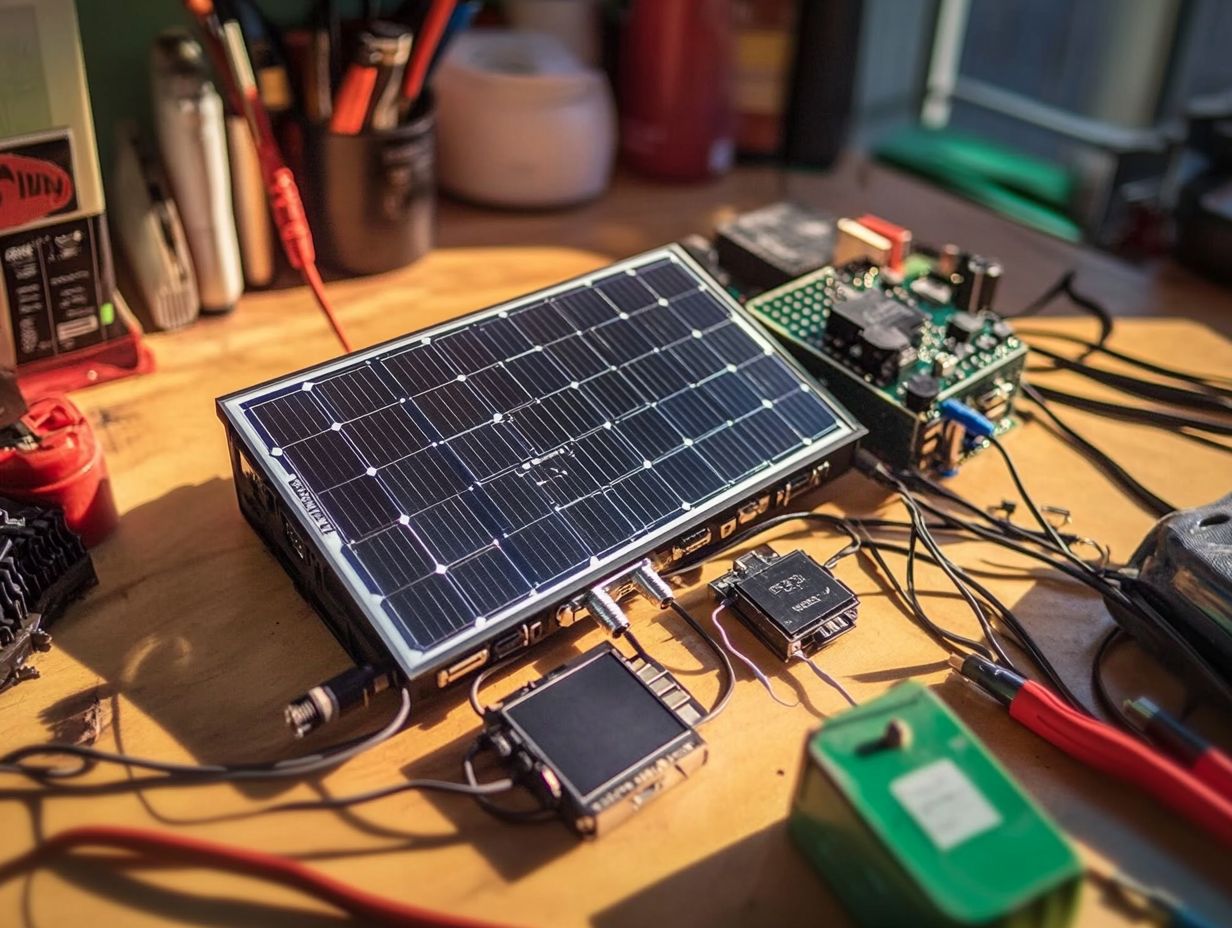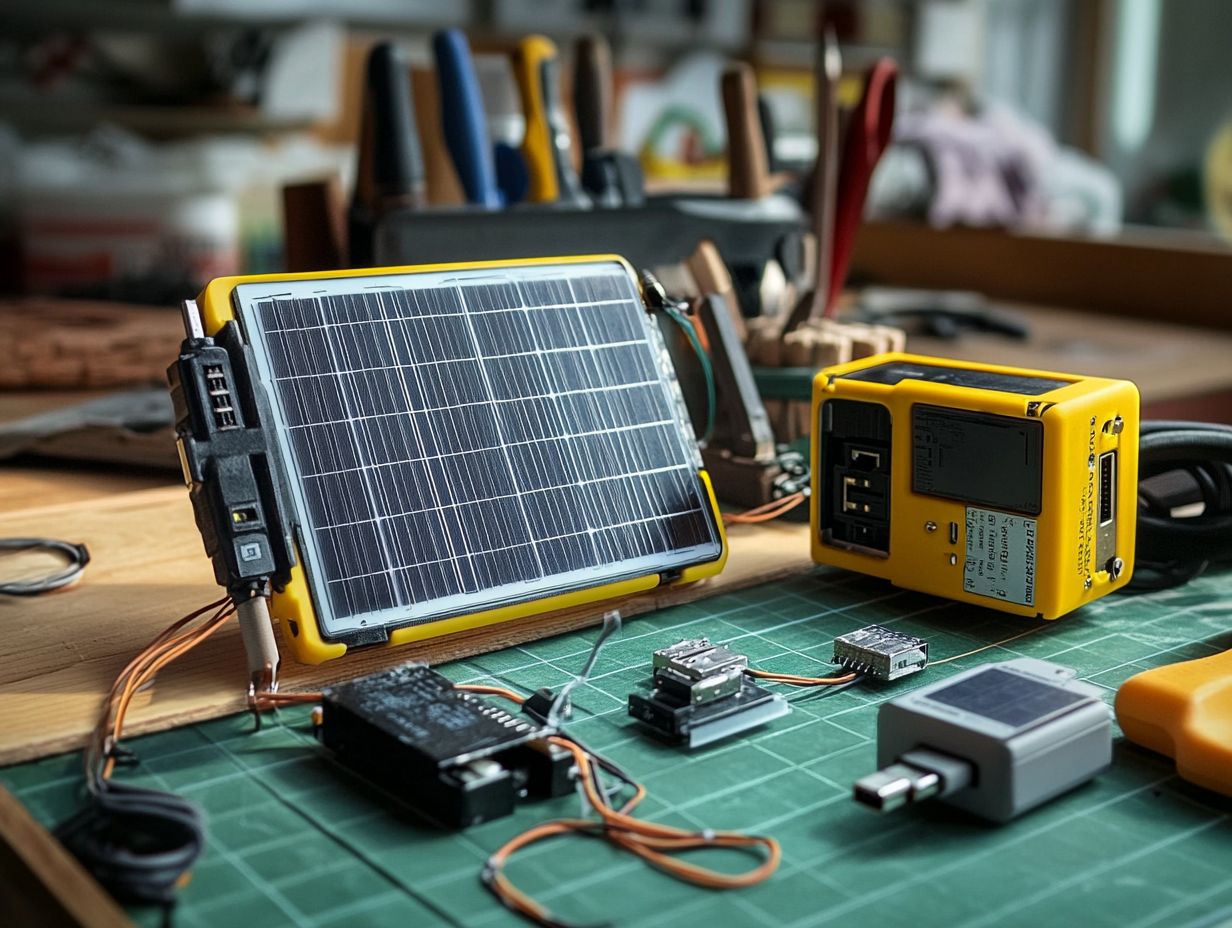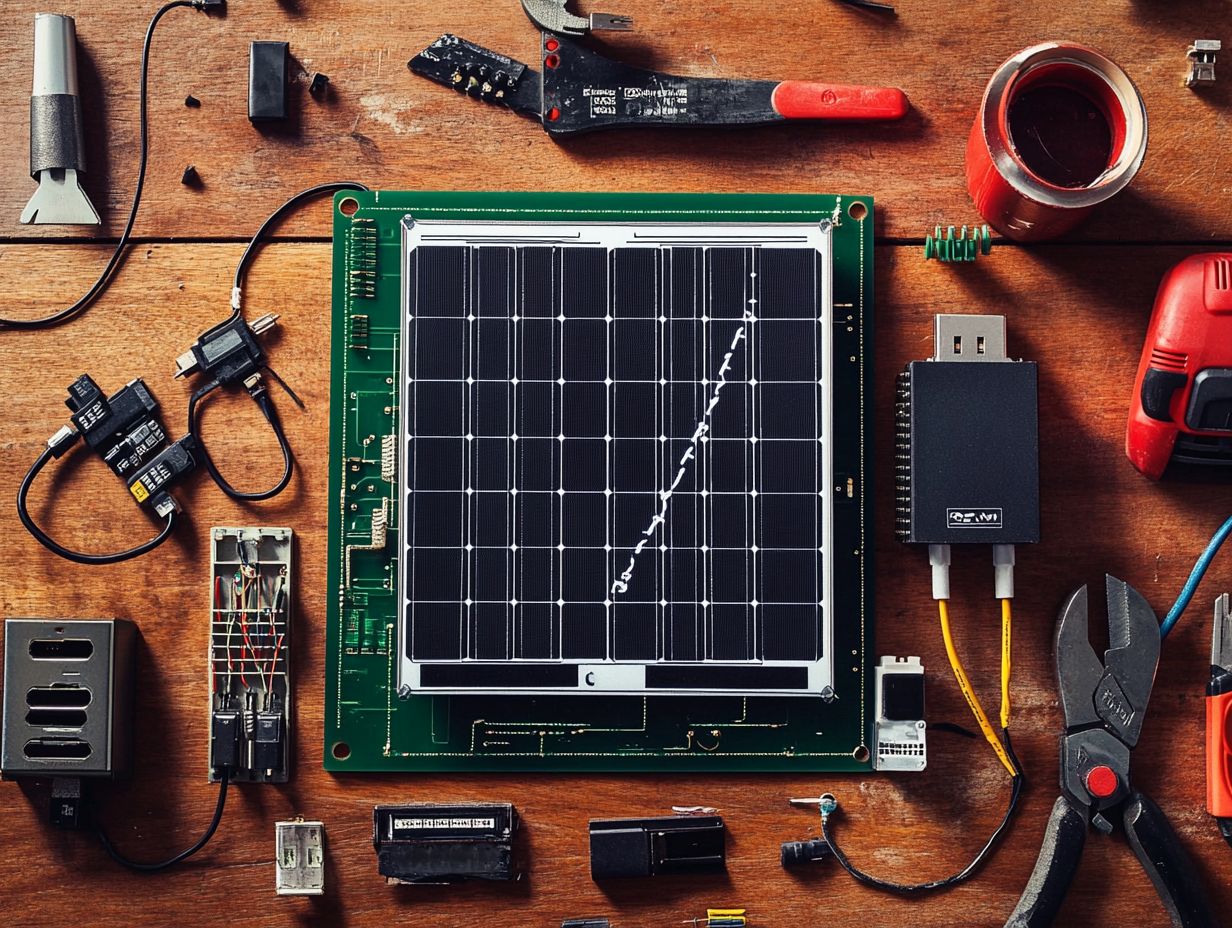How to Create a Simple Solar Charger
In a world that emphasizes sustainability, solar chargers offer a practical and eco-friendly way to power your devices. This guide explores how to craft your own solar charger and highlights the many environmental and financial benefits it provides.
You ll discover the materials and tools required for the project, along with clear, step-by-step instructions for building and assembling your solar panel. You will also find tips to optimize its performance, ensuring you get the most out of your creation, whether you aim to create a solar power bank or a solar battery charger.
Whether you re an experienced DIY aficionado or simply a curious beginner, get ready to dive in! This guide is packed with valuable insights to help you harness the sun’s power effectively.
Contents
- Key Takeaways:
- Benefits of Using a Solar Charger
- Materials and Tools Needed
- Step-by-Step Instructions
- Tips for Optimal Performance
- Frequently Asked Questions
- How do I create a simple solar charger?
- What type of solar panel should I use for a simple solar charger?
- Do I need any special tools or skills to create a simple solar charger?
- How can I make my simple solar charger more efficient?
- Can I use a simple solar charger to charge multiple devices at once?
- Are there any safety precautions I should take when using a simple solar charger?
Key Takeaways:

- By using a solar charger, you can save money on your electricity bill and reduce your carbon footprint through sustainable living.
- You ll need basic materials such as solar cells, a battery, and a charge controller to create a simple solar charger. Tools like a soldering iron and an understanding of diode connections are also essential.
- Follow step-by-step instructions to build a solar panel and assemble the charger, and don’t forget to maximize sunlight exposure and care for your charger to ensure optimal performance.
What is a Solar Charger?
A solar charger is an innovative device that harnesses solar energy, transforming sunlight into electrical energy to power your various electronic devices whether it s your phone, tablet, or other solar appliances. These eco-friendly chargers utilize solar panels equipped with photovoltaic cells, which are devices that convert sunlight into electricity. This makes them a sustainable choice for outdoor adventures and a valuable ally in the quest for clean energy. By embracing renewable energy, solar chargers help reduce your reliance on the power grid while providing a cost-effective solution for both personal use and educational science projects.
The technology behind these chargers is truly captivating. It features components like rechargeable batteries and diodes that are essential to the charging process. When sunlight strikes the photovoltaic cells, it produces direct current (DC) electricity, which is then funneled into the rechargeable battery for storage. Diodes play a critical role by ensuring that energy flows in only one direction, preventing any backflow that could drain the battery. Using a diode like the 1N914 Diode can be particularly effective in managing power flow.
With USB charging capabilities, these devices effortlessly power a variety of gadgets while championing energy efficiency. Transitioning to solar chargers not only enhances your convenience but also contributes to a cleaner planet by leveraging a limitless resource: the sun. Additionally, integrating wireless charging into your solar-powered setup can provide an extra layer of convenience.
Benefits of Using a Solar Charger
Using a solar charger offers a wealth of benefits that span environmental, economic, and convenience factors, making it an appealing choice for anyone eager to embrace renewable energy.
These eco-friendly devices not only help reduce your carbon footprint by harnessing clean energy, but they also lessen your reliance on conventional power sources. In doing so, you contribute to sustainable living and actively promote the integration of solar energy into your everyday life.
Start building your solar charger today and embrace a more sustainable lifestyle!
Environmental and Cost Benefits
Solar chargers have impressive environmental benefits. They support renewable energy, minimize greenhouse gas emissions, and encourage sustainable living practices. By opting for solar power over conventional electricity, you contribute to cleaner air and a reduced carbon footprint!
You ll also enjoy the added perk of lower electricity bills in the long run. Solar chargers play a vital role in conserving precious natural resources by diminishing your reliance on fossil fuels, which are often finite and detrimental to the environment. This shift to solar energy not only cuts down on pollution but also nurtures a more sustainable ecosystem.
The financial savings that come with solar technology can be significant; those who embrace solar charging solutions often find themselves with lower energy costs and less maintenance hassle. These factors highlight how investing in solar energy enhances energy efficiency and delivers remarkable financial benefits for those who are environmentally conscious.
Consider exploring options like a low-cost project or creating your own solar oven to further maximize benefits. Start your solar charger project today to enjoy the advantages of renewable energy!
Materials and Tools Needed
To build a solar charger, you will need a carefully curated selection of materials and tools to ensure a successful assembly and optimal performance. Start with a 6V mini solar panel that captures sunlight efficiently. You ll also need AA rechargeable batteries! They store the energy you collect. Including a diode, like the 1N914 Diode, is also crucial. This small device controls the flow of electricity.
Don’t forget the essential electrical equipment, including a soldering iron for creating solid connections. Incorporate a USB charger and ensure proper power flow to streamline the charging process for your devices.
With the right components in hand, you’ll be well on your way to utilizing the strength of the sun.
List of Required Items

To create your own solar charger, you’ll need a well-thought-out list of essential items to ensure effective construction and operation. Start with a 6V mini solar panel, which will be your primary tool for harnessing solar energy. Pair it with AA rechargeable batteries to store that precious energy, and don t forget a diode, like the 1N914! This little component is vital for managing current flow and preventing any pesky voltage drops.
Incorporating a charge controller into your setup is crucial; it regulates the voltage and ensures that your batteries are charged safely, mitigating the risk of overcharging, which can drastically shorten their lifespan. You’ll also need wires with proper insulation to securely connect these components and facilitate the flow of electricity from the solar panel to the batteries.
Adding a voltmeter to your project can provide real-time feedback on charging parameters, helping you optimize the performance of your solar device. Finally, a sturdy case is essential to protect the components from environmental factors, ensuring longevity and efficiency in energy storage. Proper container fitting will ensure that all components are securely placed. For those interested in a more comprehensive approach, learn how to create a homemade solar battery bank. Together, these elements are key to building a highly effective solar charger!
Step-by-Step Instructions
Follow these steps to build your solar charger and enjoy clean energy! Constructing your own solar charger requires following a detailed series of step-by-step instructions that will expertly guide you through the building and assembly processes. This ensures you can harness solar energy effectively for charging your electronic devices.
Engaging in this project not only deepens your understanding of solar circuits and components but also offers invaluable hands-on experience with renewable energy technologies, making it an excellent activity for an educational science project.
Building the Solar Panel
Building the solar panel is a pivotal step in creating your solar charger. It requires careful assembly of various electrical components that work harmoniously to capture and convert solar energy effectively.
Start by connecting the solar cells to the diode. Make sure to orient them correctly for optimal current output and maximum power point for enhanced efficiency.
Once the cells are linked, integrate voltage regulators to keep the output voltage steady. This is crucial for the overall productivity of your system. Pay meticulous attention to polarity when making these connections; incorrect placements can lead to inefficiencies or even damage. Ensure the solar cells are wired in series or parallel based on your desired output voltage and current specifications. For some applications, a step-up inverter may also be necessary to achieve the desired charging voltage. If you’re looking for a complete guide, check out how to make your own solar water pump to enhance your DIY projects.
With these connections firmly established, secure the assembly in a robust frame to protect the solar panel from environmental stressors, enhancing its longevity and maximizing energy efficiency.
Assembling the Solar Charger
As you assemble the charger, your goal is to integrate all components into a seamless solar circuit that facilitates energy storage and efficient device charging.
Start by securely placing the battery holder into the designated container. Then, connect the USB charger to the circuit to kick off the charging process for various solar devices. For those interested in maximizing their solar setup, learning how to build a battery bank for solar energy can be beneficial. Proper current control will enhance the overall efficiency of the charging process.
Next, position the solar panel carefully to maximize sunlight exposure. Connect its positive and negative terminals to the charge controller. This step is vital for regulating the current flow effectively, thus avoiding any potential voltage drop.
The charge controller is essential for managing the energy transfer from the solar panel to the battery. It prevents overcharging and ensures everything operates at peak performance.
Once that’s done, connect the battery to the charge controller, double-checking that the polarity aligns to maintain a safe and efficient circuit. Finally, integrate any additional solar appliances like a solar garden light or a solar LED by linking them to the USB output, which is the port used to charge devices. For those looking to optimize their setup, following these guidelines for building your own solar panel allows for convenient pop-in charging whenever sunlight is available, making the most of the stored energy.
Tips for Optimal Performance
Adopt these key practices to supercharge your solar charger s performance! To ensure your solar charger performs at its best, regular maintenance and monitoring of charging parameters are essential.
Maximizing sunlight exposure is key. Place your solar panel in direct sunlight to markedly improve the charging process. Additionally, regular care for your charger keeps it functional and energy-efficient over the long term. For those interested in more advanced setups, learning how to build a solar-powered water pump can further optimize performance in remote or outdoor settings by considering the battery capacity and current output.
Maximizing Sunlight Exposure

Maximizing sunlight exposure is essential for achieving optimal performance from your solar charger, as it directly influences the amount of energy collected and stored for later use. By positioning your solar panel in direct sunlight, free from shadows and obstructions, you enhance the efficiency of this clean energy solution, making it ideal for all your outdoor activities, including powering your solar-powered charger.
To further optimize sunlight intake, consider adjusting the angle of your solar panel throughout the day. Tilting the panel to follow the sun s trajectory can boost charging voltage and improve overall energy efficiency, facilitating a seamless charging process.
Timing matters as well; midday, when the sun is at its zenith, typically offers the most intense sunlight, allowing for maximum energy collection.
Regularly monitoring weather conditions and being prepared to reposition your solar charger when necessary can significantly impact its performance. By embracing these strategies, you ensure that your investment in solar energy delivers the best possible returns.
Caring for Your Solar Charger
Caring for your solar charger is crucial for ensuring its longevity and optimal performance over time. Incorporating regular maintenance into your routine such as cleaning the solar panel to remove dust and debris, checking connections, and monitoring battery capacity can significantly enhance its energy efficiency and prolong the lifespan of your charging device, ensuring sustainable living.
Embracing these practices not only maximizes energy storage but also aligns with your commitment to sustainable living, ensuring that your solar charger operates at peak efficiency.
When it comes time to clean, use a soft cloth and a gentle cleaner to avoid scratching the surface; this allows sunlight to penetrate without obstruction. It s wise to inspect the cables and connectors for any signs of wear or damage, as loose or frayed wires can compromise both performance and safety.
Periodically check the battery’s health to ensure it works well; replacing an aging battery can dramatically improve energy retention. By consistently taking these steps, you can effectively maintain your device, securing a reliable source of renewable energy tailored to your needs.
Final Thoughts and Recommendations
Adopting a solar charger is your gateway to sustainable living and harnessing clean energy. This choice offers numerous benefits and practicality for your daily routine. By familiarizing yourself with the construction, maintenance, and optimal use of solar chargers, you can make well-informed decisions and enhance your contribution to renewable energy initiatives.
Understanding the solar circuit and its components, such as a diode and a device that controls power flow, can further optimize your usage. For those interested in practical applications, check out this guide on how to build your own solar-powered battery charger.
These eco-friendly chargers empower you to cut down on fossil fuels and make a real difference! They also play a crucial role in lowering greenhouse gas emissions, creating a significant positive impact on the environment. Incorporating solar technology into your daily life can inspire others to follow suit, cultivating a community dedicated to sustainable solutions. Whether it s a solar garden light or a solar power bank, every step towards solar energy utilization counts.
As you evaluate your energy consumption habits, considering portable solar chargers for your travels, outdoor adventures, or even everyday tasks is increasingly relevant. The shift towards renewable energy sources symbolizes our collective commitment to preserving our planet, reinforcing the idea that even small changes can lead to substantial environmental benefits.
Frequently Asked Questions
How do I create a simple solar charger?
To create a simple solar charger, you will need a solar panel, a charge controller, and a battery. Connect the solar panel to the charge controller, and then connect the charge controller to the battery. Your solar charger is now ready to use! This can be a great science project to demonstrate the principles of solar energy and renewable energy.
What type of solar panel should I use for a simple solar charger?

For a simple solar charger, it is best to use a smaller, portable solar panel. A 5-10 watt panel is usually sufficient for charging small devices like phones and cameras, acting as an effective solar-powered battery charger.
Do I need any special tools or skills to create a simple solar charger?
No, creating a simple solar charger does not require special tools or skills. However, some basic knowledge of electrical connections and safety precautions is recommended. You will need items like a soldering iron, 1N914 Diode, and AA Rechargeable Batteries among other project materials.
How can I make my simple solar charger more efficient?
To make your solar charger more efficient, ensure the solar panel is placed in direct sunlight and angled towards the sun. You can also use a larger battery or multiple solar panels to increase the charging capacity. Adding a device that controls power flow can help manage the power flow and current output.
Join our community and share your solar energy stories with us!
Can I use a simple solar charger to charge multiple devices at once?
Yes. Your solar charger can charge multiple devices if its total capacity meets their combined energy needs. Use a device that helps manage power flow to ensure each device gets the right energy.
Are there any safety precautions I should take when using a simple solar charger?
Absolutely! Always be cautious when working with electricity. Follow the manufacturer’s instructions for safe use and maintenance.
Keep your hands off the solar panel when it s sunny! Avoid exposing the charger to water or extreme heat. Understanding how the solar circuit works can help prevent problems and keep you safe.






